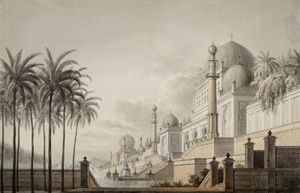A look at theatre > The theatre's appearance

Originally, scenography (from the Greek word ‘skènè’ or dressing tent) meant ‘the art of painting décors’. Designing the preliminary studies for theatrical décors and costumes is, in itself, sometimes also called scenography. In present theatrical practice, however, the word encompasses much more: the costumes, the lighting and the décors (including props), everything in its relationship to the actors, the performance and the audience.
As far back as the Greek theatre of the 4th century BC, objects or painted screens served as décor to indicate the time and place of the action on the stage. Starting in the 16th century and well into the 19th century, painted backdrops, side screens (wings), platforms, set pieces, furnishings and other props were in use on the European stage. Wide views painted in perspective and ingenious stage contraptions became highly conspicuous elements in stage plays, operas and ballets. The larger and deeper the décors, the more beautiful they were thought to be.
Around 1900, the profession started to look for a better balance between the visual and the theatrical arts on the stage. Décors became more sober and were supposed to contribute towards a deeper understanding of the play. It was no longer a matter of local colour, of background scenery, but of using colour and form to underscore the message of the play.
Read more about:
Décor and theatre in the 18th and 19th century >>
Modern scenografie >>
